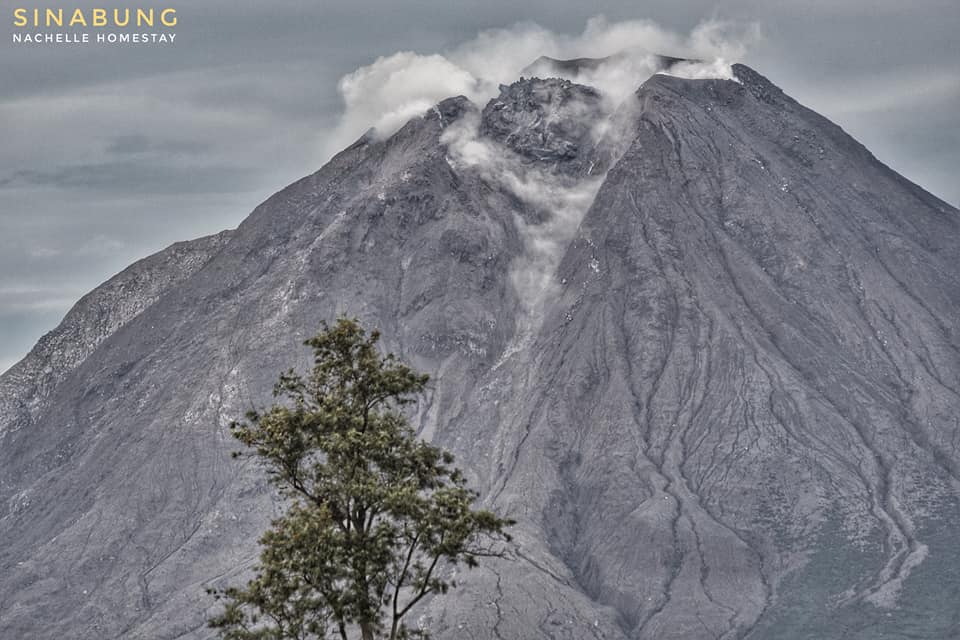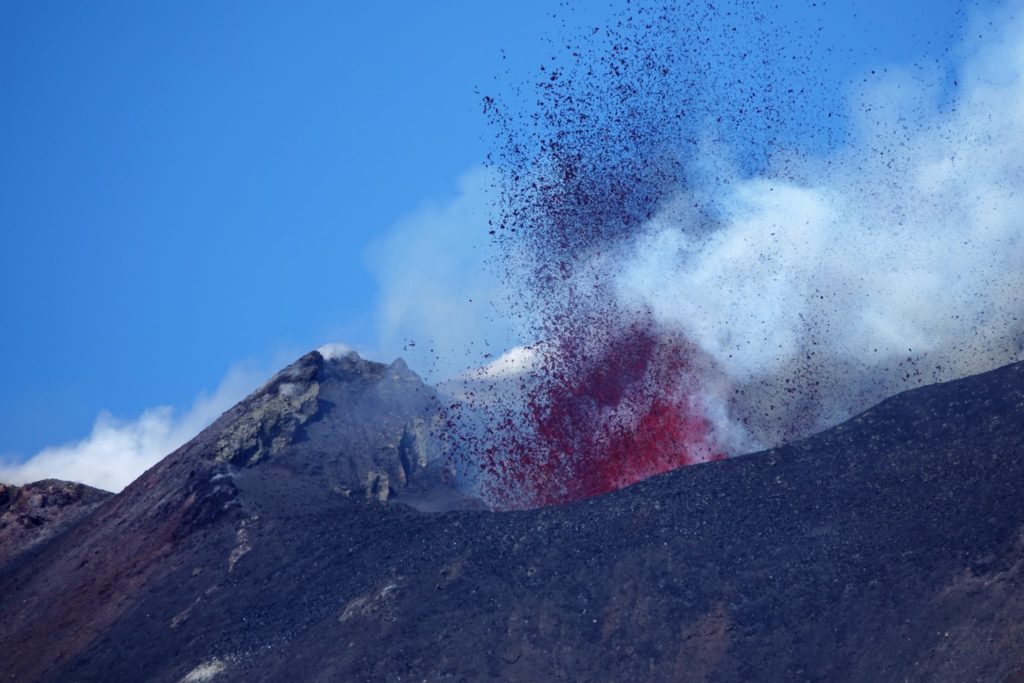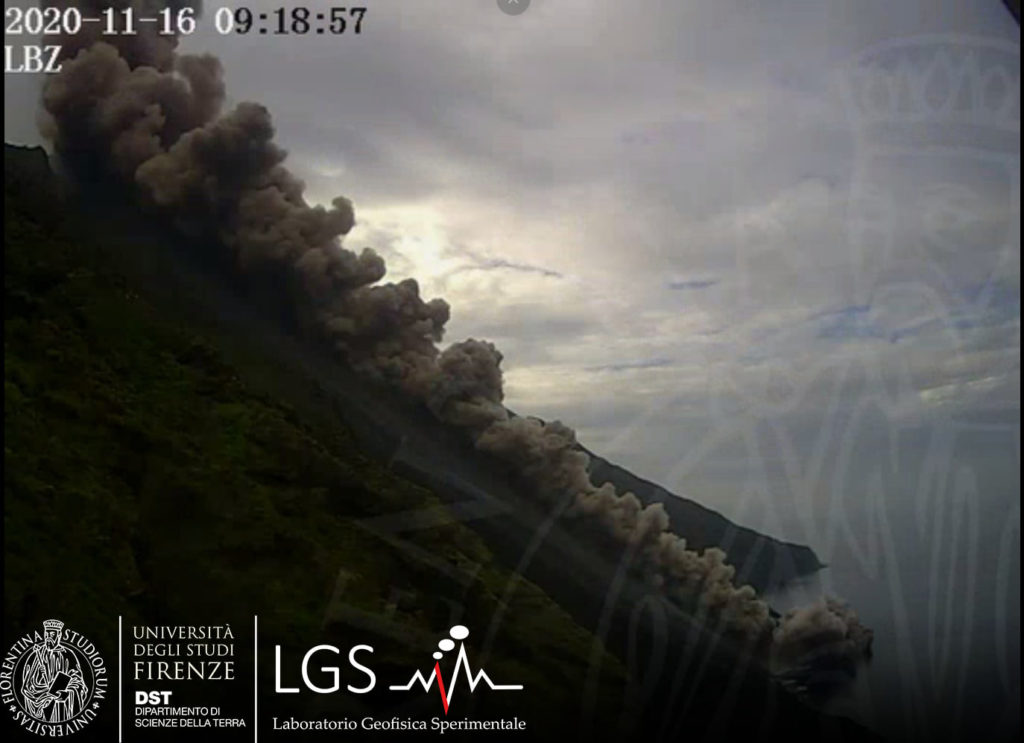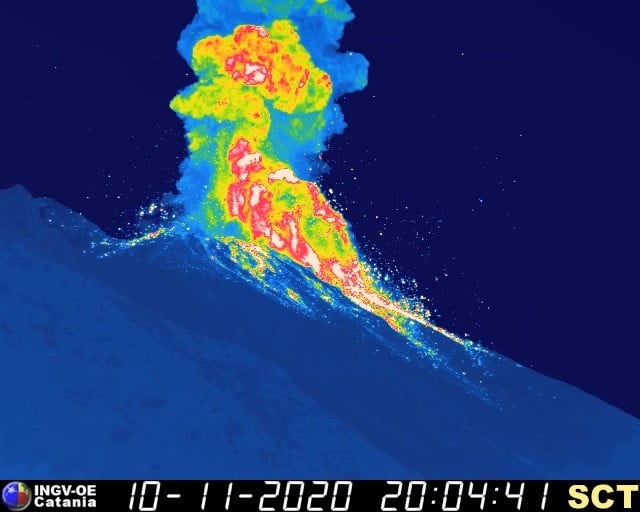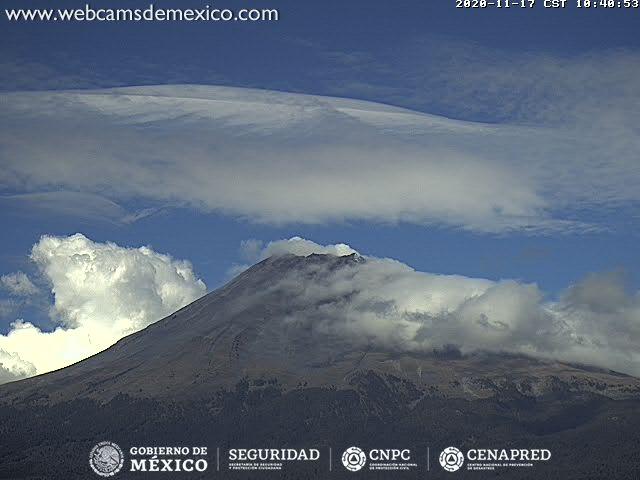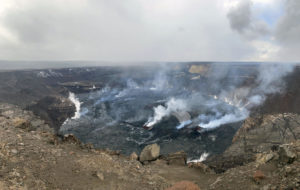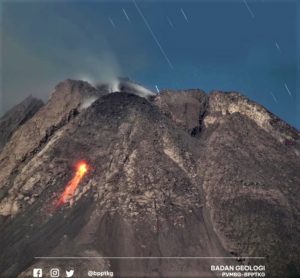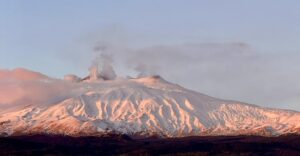November 18 , 2020.
Indonesia , Sinabung :
VOLCANO OBSERVATORY NOTICE FOR AVIATION – VONA .
Issued : November 18 , 2020
Volcano : Sinabung (261080)
Current Aviation Colour Code : ORANGE
Previous Aviation Colour Code : orange
Source : Sinabung Volcano Observatory
Notice Number : 2020SIN30
Volcano Location : N 03 deg 10 min 12 sec E 98 deg 23 min 31 sec
Area : North Sumatra, Indonesia
Summit Elevation : 7872 FT (2460 M)
Volcanic Activity Summary :
Eruption with volcanic ash cloud at 06h44 UTC (13h44 local).
Volcanic Cloud Height :
Best estimate of ash-cloud top is around 11072 FT (3460 M) above sea level, may be higher than what can be observed clearly. Source of height data: ground observer.
Other Volcanic Cloud Information :
Ash-cloud moving to south-west.
Remarks :
Seismic activity is characterized by continuous volcanic tremor, duration 160 seconds.
The activity level has been at level III (SIAGA) since May 20, 2019 at 10:00 a.m. WIB. The Sinabung volcano (2460 m altitude) has been erupting since 2013.
The volcano was clearly visible until it was covered in fog. The main crater emits white smoke, moderate to thick, with a height of about 50-300 meters above the summit. The weather is sunny to rainy, with weak to strong winds to the South, West and North-West. The air temperature is around 16-26 ° C.
According to the seismographs of November 17, 2020, it was recorded:
24 avalanche earthquakes
6 low frequency earthquakes
1 local tectonic earthquake
2 distant tectonic earthquakes.
Source : Magma Indonésie , PVMBG.
Photo : Nachelle Homestay .
Italy / Sicily , Etna :
Weekly bulletin, from November 09, 2020 to November 15, 2020, (issue date November 17, 2020)
SUMMARY OF THE STATE OF ACTIVITY
In the light of surveillance data, it is highlighted:
1) VOLCANOLOGICAL OBSERVATIONS: Strombolian activity of variable frequency and intensity accompanied by discontinuous ash emissions at the New Southeast Crater. Intra-crater strombolian activity at the Northeast Crater, intermittent Strombolian intracrater activity at the Bocca Nuova crater, associated with slight ash emissions and degassing.
Degassing activity at the Voragine crater.
2) SEISMOLOGY: low seismic activity of fracturing; average amplitude of volcanic tremor fluctuating in the range of medium and high values.
3) INFRASOUND: Modest infrasound activity.
4) DEFORMATIONS: During the last week, the trend of the time series of Etna soil deformation monitoring networks has not shown any significant changes.
5) GEOCHEMISTRY: The flow of SO2 is at a medium-low level
HCl flow occurs at an average level.
The flow of CO2 from the soil is maintained on a low degassing regime.
The partial pressure of dissolved CO2 does not show significant changes.
The value of the C / S ratio is at medium-low levels (last measurement available on 10/16/2020).
The helium isotope ratio is at average values (last update 04/11/2020).
6) SATELLITE OBSERVATIONS: The thermal activity in the summit area is at a medium-low level.
VOLCANOLOGICAL OBSERVATIONS:
During the week, the monitoring of the volcanic activity at the level of the summit craters of Etna was carried out by analyzing the images of the network of surveillance cameras of the INGV section of Catania, Osservatorio Etneo (INGV-OE) and by an inspection carried out by INGV-OE staff on November 12.
In the period considered, the summit craters were mainly characterized by intracrater Strombolian activity with discontinuous ash emissions at the New Southeast Crater (NSEC) and by Strombolian intracrater activity of the Northeast crater (NEC) and from the crater of Bocca Nuova (BN).
The Northeast Crater (NEC) during the inspection of November 12 showed less intense Strombolian activity than that observed the previous week (see Rep. N.46 / 2020). In particular, on the bottom of the crater, one vent showed almost continuous strombolian activity, a second vent was affected by discontinuous activity, while a third vent, consisting of a hornitos, was affected only by degassing . Overall, Strombolian explosions manifested themselves at times as more forceful events, producing launches of coarse material that reached heights of several tens of meters above the crater rim and the products occasionally fell back to the crater. exterior, settling on the flanks.
Regarding the intracrater Strombolian activity that began on November 5 at the Bocca Nuova crater (see Rep.N. 46/2020), it moved from the crater of the BN1 pit, which was obstructed by the material collapsed from the internal walls, towards the crater of the BN2 pit which in the days preceding the inspection of November 12 had produced a more energetic activity with the launching of fresh materials which fell on the south terrace of the crater. Globally from the crater of Bocca Nuova, during the week considered, modest emissions of very diluted ash were observed.
Finally, the New Southeast Crater was characterized by intracrater Strombolian activity of varying frequency and intensity from the mouth of the saddle, which produces the launch of coarse pyroclastic material well beyond the edge of the saddle. crater, sometimes accompanied by sporadic emissions of ash quickly dispersed by high-altitude winds. On November 15, a weak ash emission, light gray in color, was observed from the vent located on the east side.
Source : INGV.
Photos : Gruppo Guide Alpine Etna Sud ( 1 octobre
Italy , Stromboli :
Weekly bulletin, from November 09, 2020 to November 15, 2020, (issue date November 17, 2020)
SUMMARY OF THE STATE OF ACTIVITY.
In the light of surveillance data, it is highlighted:
1) VOLCANOLOGICAL OBSERVATIONS: Normal explosive activity of Strombolian type on medium-low levels (6-10 events / h) and medium intensity both in the areas of the North and Center-South crater interrupted on November 10 by a sequence high-energy explosive produced in the Center-South zone.
2) SEISMOLOGY: The monitored seismological parameters and the dilatometric data do not show significant variations, with the exception of the two high intensity explosions recorded at 20:04 UTC on 11/10 and at 09:17 UTC on 16/11.
3) DEFORMATIONS: The island’s soil deformation monitoring networks did not show any significant changes to report for the period under review.
4) GEOCHEMISTRY: SO2 flow at medium-low level
C / S Ratio – Latest values (C / S = 10) are average levels.
The isotopic ratio of helium is at average values (R / Ra = 4.38 sampling of November 03).
5) SATELLITE OBSERVATIONS: The thermal activity in the summit area is at a low level.
VOLCANOLOGICAL OBSERVATIONS
During the period under observation, the eruptive activity of Stromboli was characterized by the analysis of the images recorded by the surveillance cameras INGV-OE located at 190 m altitude, Punta deiCorvi and 400 m.
On November 10, 20 from 20:04 UTC, the crater terrace was affected by a high energy explosive sequence that affected the Center-South area.
Chronology of the event. On November 10, 2020 at 20:04:21 UTC, an explosive sequence begins from the Center-South area of the crater terrace. The first impulse which opens the explosive sequence seems to be located in the South zone of the CS zone (S2) and after a few seconds it extends to the whole South zone. It is the main explosion which produces most of the pyroclastic materials emitted which fall radially, and abundantly along the Sciara del Fuoco; it is followed by the emission of an ash plume which rises perpendicularly to the terrace. The duration of the event is approximately 27 s.
After a few seconds at 20:04:51 UTC a second pulse is probably generated in the North zone of the CS zone (C) producing an intense fountain which after an initial peak whose coarse products reach 300 m in height, slowly decreases until until it runs out at 20:06:06. At 20:06:46 a small explosion at vent N2 concludes the explosive sequence. The total duration of the event was approximately 2 minutes and 30 s.
Thermal and morphological analysis following the aerial overflight of 11/11/2020, carried out with the helicopter provided by the 2nd Aero Unit of the Catania Coast Guard.
The investigation showed that the summit craters had degassing activity that affected the entire crater area. In particular, the S1 and C craters located in the southern area of the crater terrace did not show explosive activity at the time of the flyover, but at the bottom of the crater there were thermal anomalies that indicated the presence of superficial magma. and in crater S1 there was also a small lava flow from an intracrater vent. On the external face of the same crater, on the Sciara del Fuoco, there was a hornito indicated in figures h1 in an area of intense fumaroles.
The craters of the northern zone N1 and N2 also exhibited thermal anomalies which indicated a high level of magma, in particular the N1 crater on the outer slope in front of the Sciara del Fuoco, where it was detected hot material ebbing on the along an already existing erosive furrow. The material, partially accumulated and partially collapsed, at lower elevations along the Sciara is clearly visible in the figure. The N2 crater had a second hornito on the slope of the Sciara del Fuoco.
Overall, the thermal images show that the fallout was mainly distributed over the Sciara del Fuoco, some blocks still very hot, and therefore of metric size, fell in the southern sector of the crater terrace, the strong degassing and the strong emission of steam, prevented the relief of any material that might have fallen on the Pizzo sopra la Fossa.
Description of eruptive activity recorded by surveillance cameras.
In the area of the north crater, the N1 crater, with two emission points, produced explosions of low intensity (less than 80 m high) to medium-high intensity (sometimes the projectiles reached 250 m high) emitting coarse materials (lapilli and bombs) sometimes mixed for purposes (ash). The N2 mouthpiece, with three emission points, showed mainly low and medium intensity explosive activity emitting coarse materials sometimes mixed with finer materials. The average frequency of explosions fluctuated between 6 and 10 events / h.
In the Center-South zone, the explosions (not located in the individual vents) mainly emitted fine materials with an average intensity (the products reached 150 m in height).
The explosive activity showed frequency values varying between less than 1 and 2 events / h.
Source : INGV .
Photos : LGS – Laboratorio Geofisica Sperimentale , INGV .
Mexico , Popocatepetl :
November 17, 11:00 a.m. (November 17, 5:00 p.m. GMT)
During the last 24 hours, according to the monitoring systems of the Popocatépetl volcano, 378 exhalations have been identified, accompanied by emissions of water vapor, volcanic gases and small amounts of ash. In addition, 59 minutes of tremor and a volcano-tectonic earthquake were recorded yesterday at 09:55 am, with a calculated magnitude of 1.9.
At the time of this report, there is a slight emission of volcanic gases dispersed towards the northwest.
CENAPRED urges NOT TO APPROACH the volcano and especially the crater, because of the danger posed by the fall of ballistic fragments and, in the event of heavy rains, to stay away from the bottom of the ravines because of the danger of lava flows. mud and debris.
The Popocatépetl volcanic alert semaphore is on YELLOW PHASE 2.
Source et photo : Cenapred .

